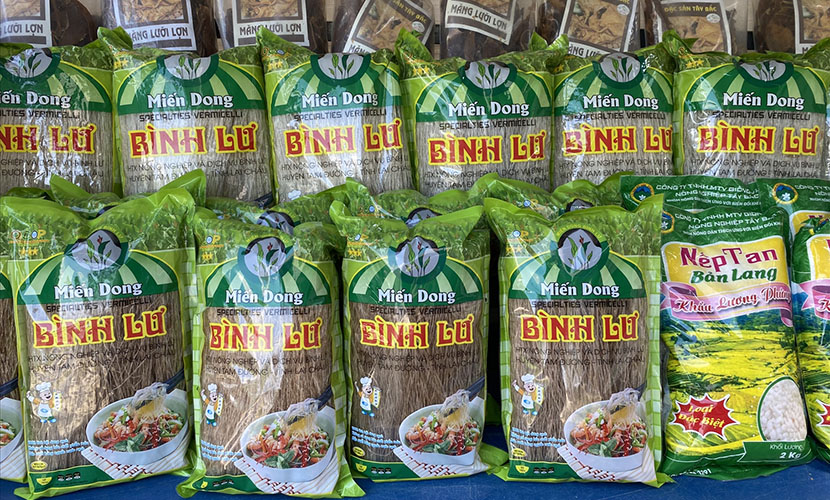
Binh Lu is a remote commune in Tam Duong District, a mountainous area of Lai Chau Province. The commune is famous for growing arrowroot plants and producing Binh Lu canna vermicelli (miến dong Bình Lư). It is a well-known vermicelli brand in Vietnam and among Vietnamese communities overseas
After nearly a year of diligent care, the arrowroot plants have now reached the harvest time. Arrowroot growers in particular, and the traditional vermicelli craft village of Binh Lu Commune, have become bustling again. The vermicelli production season has begun to serve consumers during the Lunar New Year.
Despite the cold winter weather mixed with drizzle, the labor atmosphere remains lively across the fields of Binh Lu commune. During the main harvest season, local farmers are busy harvesting arrowroot. Laughter and joyful voices echo throughout the fields, clearly showing the excitement of a successful arrowroot harvest.

Binh Lu canna vermicelli
Mr. Hanh and his family have been making Binh Lu canna vermicelli since the 1980s. He recounted that in the past, growing the old variety of arrowroot, which was laborious, generated low yields. Since 2010, with the new arrowroot variety, he has planted about 6,000 square meters.
This harvest season, his family collected about 25 tons of fresh roots. After subtracting costs for seeds and fertilizers, his family earned a profit of over 50 million VND.
“Growing arrowroot is hard work. However, it yields 2-3 times more income than rice, with care required mostly in the early stages. Additionally, my family processes around thirteen tons of dried vermicelli annually to sell both locally and nationwide. We also participate in the cooperative producing the Binh Lu three-star OCOP vermicelli product. Our yearly income is about 200 million VND after costs,” Mr. Hanh shared.
Before 2021, Mr. Son, another villager, grew two rice crops annually. In 2022, he decided to switch to arrowroot cultivation. He calculated that growing rice yielded 1.2 tons of paddy rice, with a profit of 1.2 million VND. However, growing arrowroot brought in a total of 27 million VND, with a profit of 12 million VND.
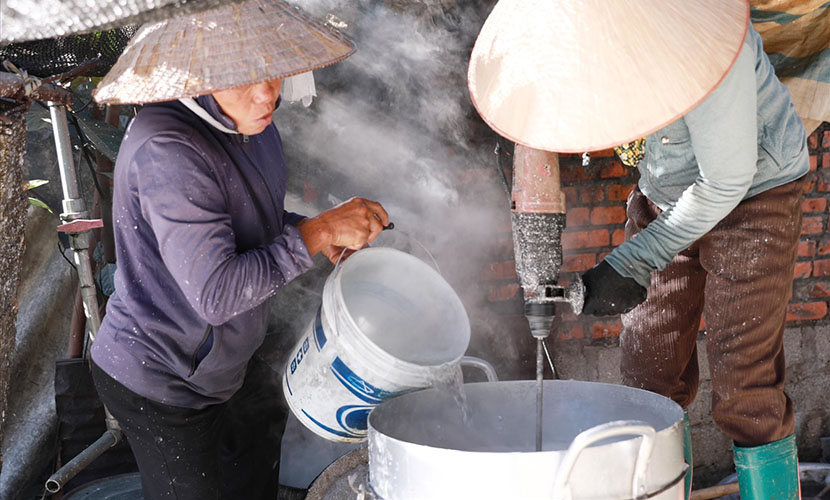
Making canna starch for vermicelli
Currently, vermicelli production facilities in Binh Lu commune are mobilizing maximum labor resources. IN the meanwhile, they are investing in modern technology and applying scientific advances to meet consumer demand.
Mrs. Huong’s family in Tong Pan hamlet has dedicated to Vietnam’s traditional vermicelli making for 34 years. This side business has provided extra income for her family.
She shared, “Taking advantage of the warm and sunny weather, from early November, my family has started producing vermicelli. We make about 130 kilograms daily and sell as we produce. Our vermicelli strands are thin, chewy, and delicious, popular with many consumers.”
To enhance the quality, Vung Tam Cooperative has invested in a production workshop totaling nearly 900 square meters. Notably, the facility invested in modern machinery system. They included boilers for heating drying racks, batter spreading machines, noodle-cutting machines, and drying rooms for vermicelli strands of various thicknesses.
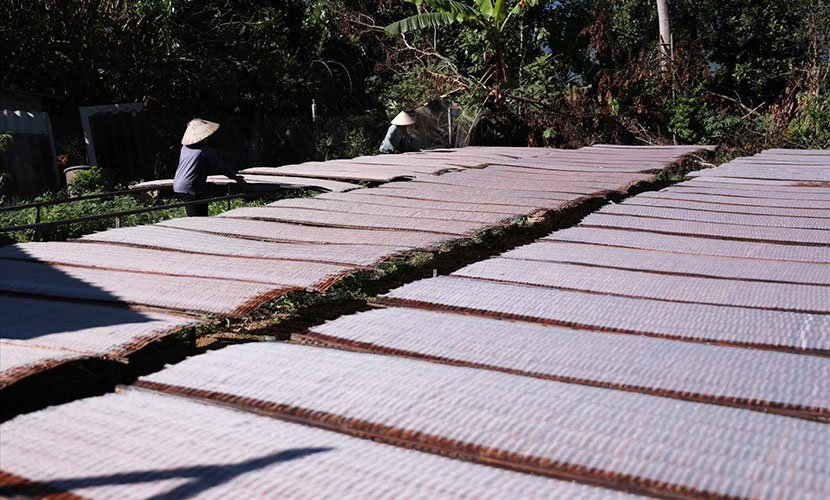
Drying Binh Lu canna vermicelli
To process over three tons of batter, the machines operate continuously for ten hours daily. At the same time, two technicians constantly monitor them to ensure quality.
Mr. Tam, Director of the cooperative, said, “Our vermicelli products are carefully packaged with attractive designs, labels, and complete information on the production date, expiry date, and usage instructions. This attention to detail has earned customer trust. Thanks to local raw materials and modern equipment, we produce around two tons of vermicelli daily. To meet Tet demand, the cooperative plans to produce 140-150 tons of Binh Lu canna vermicelli.”
Mr. Cuong, from Thong Nhat hamlet, established a vermicelli production business in 2019 to preserve and develop his family’s craft. After three years, he expanded his scale to access a larger market. Consequently, the Ngoc Cuong cooperative was established, launching premium vermicelli products under the brand “Gia Huy vermicelli”. This brand was popular with beautiful packaging and straight, uniform, fragrant, and delicious strands.
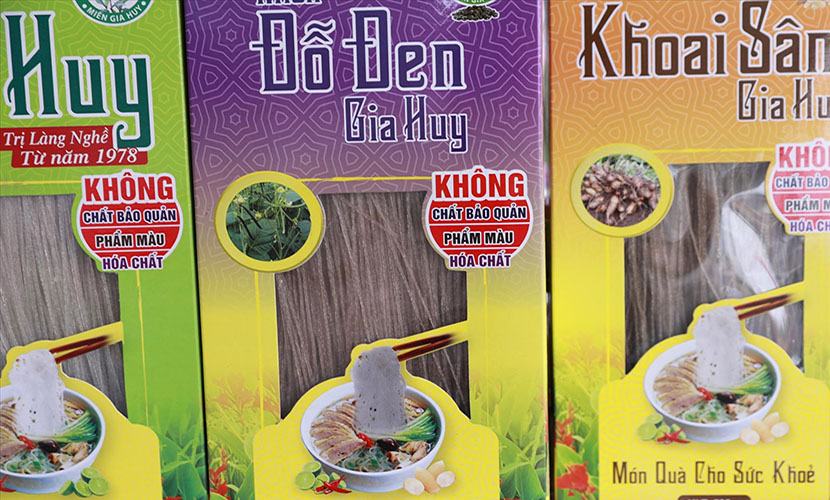
Various products of Gia Huy vermicelli
Mr. Cuong shared, “I focus on investing and applying scientific and technical advances in production. We replcae traditional machines with semi-automatic noodle pressing machines, self-made dough mixers, and mesh mats instead of bamboo mats during the drying process. Currently, the cooperative has three vermicelli production sites, producing 26–27 tons annually with profits of over 200 million VND after expenses. It also provides stable jobs for nine workers, each earning a monthly salary of six million VND.”
Currently, Binh Lu commune has two craft villages with nearly 100 households producing vermicelli. Annually, production facilities supply more than 200 tons of vermicelli to the market. The “Binh Lu canna vermicelli” brand has become a reputable name nationwide, favored and trusted by consumers both inside and outside the province.
To increase production volume and quality, Binh Lu commune has recently strengthened communication and encouraged residents to grow arrowroot. Meanwhile, the commune linked with growers in neighboring areas to supply local raw materials for vermicelli production.
At the same time, it encouraged production facilities to invest in modern machinery and apply scientific and technical advances to save time and labor, improve productivity, and meet market demands during Tet.
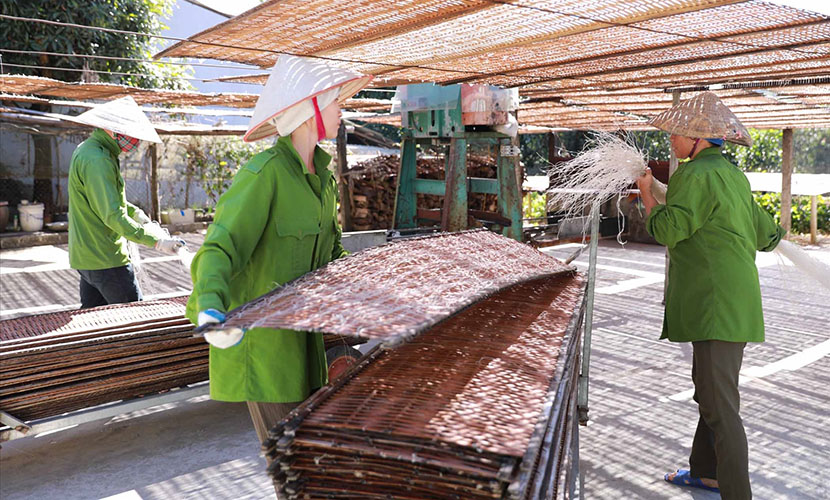
Binh Lu canna vermicelli process
Thanks to this, Binh Lu canna vermicelli meets quality standards and food safety regulations, with uniform strands and attractive packaging. It has secured a strong brand position in the market.
Mr. Thang, Vice Chairman of Binh Lu commune, shared: “In recent years, we have made efforts to enhance the reputation and output of vermicelli production, resulting in relatively high incomes for producers. Arrowroot has been grown and cherished by local people for generations”.
“The vermicelli produced is favored by the market for its chewy, delicious strands. Moving forward, the commune will seek ways to support arrowroot growers and coordinate product consumption to gradually increase income and create jobs for local people,” he added.
Vietnamese source: https://baodantoc.vn/lang-mien-binh-lu-vao-vu-1735618351270.htm
